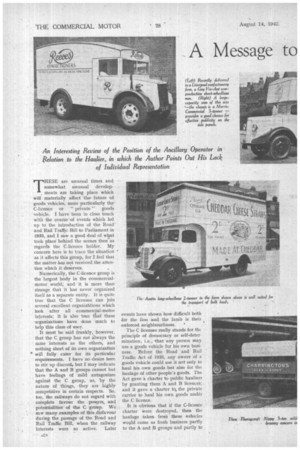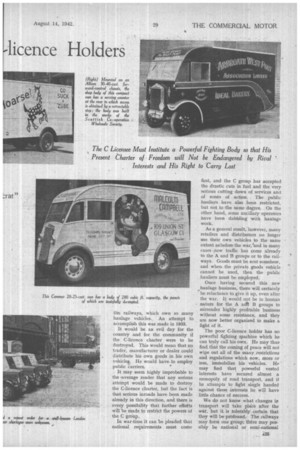A Message to
Page 26

Page 27

Page 28

If you've noticed an error in this article please click here to report it so we can fix it.
-licence Holders
An Interesting Review of the Position of the Ancillary Operator in Relation to the Haulier, in which the Author Points Out His Lack of Individual Representation The C Licensee Must Institute a Powerful Fighting Body so that His Present Charter of Freedom will Not be Endangered by Rival Interests and His Right to Carry Lost
THESE are unusual times and somewhat unusual developments are taking place which will materially affect thefuture of goods vehicles, more particularly the C-licence or " private " goods vehicle. I have been in close touch with the course of events which led up to the introduction of the Road' and Rail Traffic Bill to Parliament in 1933, and I saw a good deal of wbat took place behind the scenes then as regards the C-licence holder. My concern here is to trace the situation as it affects this group, for I feel that the matter has not received the atten
tion which it deserves. .
Numerically, the C-licence group is the largest body in the commercialmotor world; and it is more than strange that it has never organized itself as a separate entity. It is quite true that the C licensee can join several excellent organizAtions which
. look after all commercial-motor interests; it is also true that these organizations have done much to help this class of user.
It must be said frankly, however, that the C group has not always the same interests as the others, and nothing short of its own organization ' will fully cater for its particular requirements. I have no desire here to stir up discord, but I may indicate that the A and B groups cannot but have feelings of mild antagonism against the C group, as, by the nature of things, they are highly competitive in certain respects. So, too, the railways do not regard with coinplete favour the pow„ets, and potentialities of the C group. We saw many examples of this disfavour during the passage of the Road and Rail Traffic Bill, when the railway interests were so active. Later events have shown how difficult both for the lion and the lamb is then enforced neighbourliness. • The C licensee really stands for tilt principle of democracy or self-determination, i.e., that any person may use a goods vehicle for his own business. Before the Road and Rail Traffic Act of 1933, any owner of a goods Vehicle could use it not only to haul his own goods but also for the haulage of other people's goods. The Act gave a charter to public hauliers by granting them A and B licences; and it gave a charter to, the private carrier to haul his own goods Lind& the C licence.
It is obvious that if the C-licence charter were destroyed, then the haulage taken from these vehicle would come as fresh business partly to the A and B groups and partly to tlre railways, which own so many haulage vehicles. An attempt to accomplish this was made in 1933.
It would be an evil day for the country and for the community if the C-licence charter were to be destroyed. This would mean that no trader, manufacturer or dealer could distribute his own goods in his own vehicles. He would have, to employ public carriers.
It may seem highly improbable to the 'average reader that any serious attempt would be made to destroy the C-licence charter, but the fact is that serious inroads have been made already in this direction, and there is every possibility that further efforts will be made to restrict the powers of the C group.
In war-time it can be pleaded that national requirements must come
first, and the C group has accepted the drastic cuts in fuel and the very serious cutting down of services and of zones of action. The public hauliers have also been restricted, but not to the same degree. On the other hand, some ancillary operators have been dabbling with haulage work.
As a general result, however, many retailers and distributors no longer use their own vehicles to the same extent as before the war,"and in many cases new traffic has come already to the A and B groups or to the railways. Goods must be sent somehow, and when the private goods vehicle cannot be used, then the public hauliers must be employed.
Once having secured this new haulage business, there will certainly be reluctance to give it up, even after the war. It would not be in human nature for the A ant B groups to surrender highly profitable business without some resistance, and they are now better organized to make a fight of it.
The poor C-licence holder has no powerful fighting machine which he can truly call his own. He may thus find that the coming of peace will not wipe out all of the many restrictions and regulations which now, more or less, immobilize his vehicles. He ' may find that powerful vested interests have secured almost a monopoly of road transport, and if he attempts to fight single handed against these interests he will have little chance of success.
We do not know what changes in transport will take pla:ce after the war, but it is tolerably certain that they will be profound. The railways may form one group; there may possibly be national or semi-national control of public haulage. The Ministry of Transport (not " War" then, presumably) may assume new powers, hurt 'it is very likely that if C-licence holdeis be then disunited and unorganized, they will fare badly in the post-war scramble. For these reasons the big and small men of the group should get together at once and establish a truly representative ancillary operators' association.
The foregoing was written before the announcement of the S.J.C. plan, but the latter does not conflict, with it, except that the ancillary operators might find a better title for their suggested body.
I would here impress upon Clicensees the urgency of the job. It is well known that the railways are planning big moves which will be ready, for action 'wh,en peace comes. These moves will also concern the haulier groups, certain of which may become associated with the railways.
One marked development in postwar commercial planning is the efforts which are being made to squeeze out the small man or the individual trader. We may see the same process in road, transport ' directed against the C-licence group, which, normally, is composed of individual carriers, and so is comparable to the "small man" in business. The matter is further complicated by the progress made in contract' work, where organizations exist which farm out special vehicles and drivers to business houses for their own haulage affairs. This system -has many advantages, and war-time experience may lead to further evolution.
But even is the private car has rewained the main class in passenger transport by road, it may well be that a very large number of commercial firms will retain their own fleets of vehicles, and the "small man" will use his own vehicle in his own way. Legislation is bound to affect all these operations after the war, and unless the ancillary operators protect their rights and interests they may find themselves faced by powerful monopolists in :transport which will make individual ownership very difficult. So I would again urge all C-licence holders to organize themselves without delay.




















































